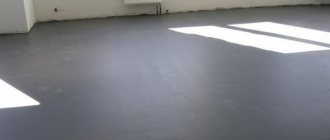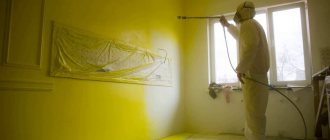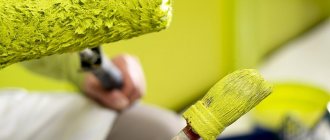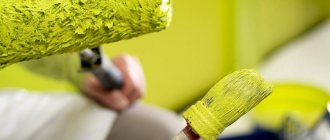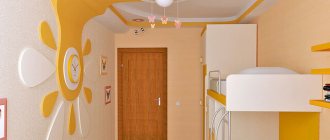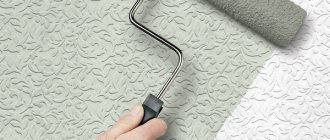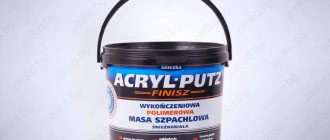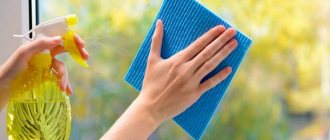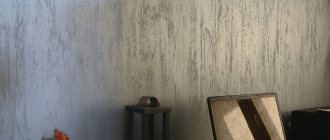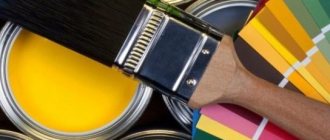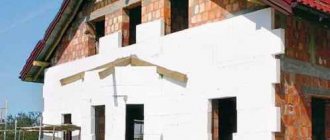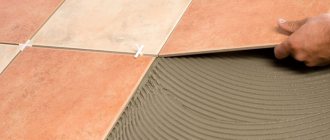Acrylic primer
The main active ingredients are acrylic polymers. The soil can rightly be called universal. It fits perfectly on brick, cement, concrete, plaster, gypsum fiber, plasterboard, wood and fiberglass substrates.
The only limitation to the use of acrylic primer is metal surfaces on which there is a high probability of rust formation. The soil significantly strengthens the base and improves its adhesion. Drying speed (2-4 hours), which significantly speeds up finishing work.
Compound:
- water;
- pigmenting additives (dyes) and auxiliary additives (mica, marble chips, etc.);
- binders that increase plasticity (resins, drying oil);
- drying catalyst (accelerates the drying process).
The percentage of components may vary depending on the application. Acrylic primer for interior work has virtually no odor when applied due to the absence of solvents.
paints and varnishes
0 votes
+
Vote for!
—
Vote against!
A primer is a special liquid composition that is applied to the surface to be treated before painting, puttying and other work. It usually contains film-forming substances (oils, resins, bitumens, various types of glue), pigments, drying accelerators and other additives. The primer base can be mineral, acrylic, alkyd, oil, etc. Paint almost always adheres better to a primer that has the same base.
Content
- Why do you need a primer?
- Application areas of primers
- Priming of mineral surfaces
- Wood processing
- Primers for metal
- Primer for other surfaces
- Some types of primers
In the recent past, for priming walls and ceilings, wallpaper glue was used (if a primer for wallpaper was required), PVA glue or silicate glue diluted with water, or paint strongly diluted with a solvent. The wood was treated with drying oil. Now on the paint and varnish market you can buy both universal inexpensive primers and high-quality highly specialized compositions from well-known manufacturers.
Modern industry offers a wide range of construction primers: deep penetration primers that reduce the absorbency of the surface, strengthening and adhesion-improving primers, insulating, anti-corrosion, fungicidal, antiseptic and other primers.
Conventionally, primers are divided into impregnations (used for the initial treatment of the base) and adhesion-improving compounds. Ready-made mixtures and dry primers that require dilution with appropriate solvents are available for sale.
Why do you need a primer?
First of all, priming the surface helps to apply subsequent layers more efficiently. In addition, such a coating will last much longer. Some types of primer compositions can regulate the porosity of the base and strengthen it. There are mixtures that prevent wear of various materials and protect them from corrosion.
In addition, the use of primers for painting will significantly reduce the consumption of expensive paint. Thanks to them, the paint lays down in an even layer and minor defects are smoothed out.
Application areas of primers
The main factor influencing the choice of the desired type of primer is the base material. Therefore, primer compositions according to their area of application can be divided into the following groups:
Priming of mineral surfaces
Mineral surfaces include brick, cinder block, concrete, aerated concrete, plaster, and so on. That is, the materials that mainly make up the walls and ceilings of buildings.
The leading position in the preparation of “bare walls” for subsequent coatings is occupied by a deep penetration primer. The mechanism of action of which is the deepest possible impregnation of the base material, while the polymer component is well bonded to the base particles, leaving the treated surface porous. This significantly increases the adhesion of the next layer to the mineral base. Often deep penetration primers have fungicidal (antifungal) additives.
If the surface is too loose, porous, or not durable, then a strengthening primer will be required. This mixture contains more adhesives, that is, when they penetrate the material, they noticeably strengthen its top layer. Note that primer consumption depends on the porosity of the surface being treated. Strengthening primers are often used when working on plaster containing insufficient amounts of cement in old buildings. But we should not forget that such mixtures strengthen the material only to the depth of their penetration - they will not save crumbling plaster.
Universal, or general purpose primer, is applied between coats. It improves adhesion, allows you to apply paint evenly, etc. When choosing it, you should take into account not only the base material, but also the layer applied next.
An anti-alkali primer is only required when using solvent-based paints to treat alkali-containing surfaces. These may include new concrete, cement screed or a surface treated with fire retardant agents.
Betonokontakt primer is used to treat smooth hard surfaces, such as concrete slabs, drywall or oil-painted substrates. This mixture contains sand and cementitious additives, which makes the surface rougher. Thus, a smooth surface with poor adhesion becomes suitable for subsequent plastering, puttying, gluing tiles and other finishing works.
Wood processing
Processing of wooden surfaces and parts is carried out in several stages. First of all, the tree must be protected from biological factors that cause destruction. These are rot, fungus, algae, insects, rodents. For protection, special impregnations are used that have antiseptic, fungicidal, pesticide, insecticidal and other components. For maximum protection of wood, these impregnations must be applied several times.
Other primers are applied to the wood before painting (in some cases they replace it): they smooth out or, conversely, expand the structure of the base. When using them, the paint lays down much more evenly, and its consumption is significantly reduced due to less absorption.
Special compositions for priming wood include products for removing tar from the surface of coniferous wood. These drugs are divided into solvents and saponifiers. After their use, mechanical treatment of wooden surfaces may be necessary.
Primers for metal
When treating metal surfaces (ferrous metals) with noticeable traces of corrosion, a rust converter is used first. After its use, mechanical processing is carried out. And only then can the surface be primed, even if the primer contains orthophosphoric acid (the main component of the converter).
Anti-corrosion primers for painting are used differently for ferrous and non-ferrous metals (galvanized iron is primed with compounds for non-ferrous metals).
Priming other surfaces
In some cases, it may be necessary to paint materials on which paint does not adhere well, and in some cases even corrodes them (tiles, glass, ceramics, plastics). For such situations, primer compounds with increased adhesion are suitable.
There are primers that block various stains (soot, grease, etc.). By using anti-stain primers, unwanted stains will not bleed through the paint or wallpaper over time.
Some types of primers
Emulsion or acrylic primer is suitable for almost all types of surfaces: brick, concrete, plaster, putty, drywall, wood, etc. The exception is metal surfaces - most of these primers do not contain an anti-corrosion component. Among the advantages of acrylic-based primers are ease of use and the ability to be diluted with ordinary water. Quick drying (in 2-4 hours) and the absence of a strong odor make acrylic primer very convenient for working in residential areas. Both surface and deep penetration primers are produced on an acrylic basis.
Alkyd primer is widely used to prepare wooden surfaces for painting; its drying time ranges from 10 to 16 hours. This primer “loosens” the top layer of wood, which significantly improves adhesion between paint and wood. Such primer greatly increases the durability of the coating and increases its service life. Alkyd primers are also used to coat iron. Not intended for use on mineral surfaces.
Epoxy and polyurethane primers are similar in composition to solvent-based paints. Basically, they are used to prime concrete bases, preparing them for the application of enamels.
Shellac primer is used to treat knots on cuts of coniferous wood. This type of primer is also used when working with water-soluble stains.
Polystyrene primers are used on plastered and wooden surfaces. But due to their high toxicity, they can only be used in well-ventilated non-residential premises or for outdoor work.
Specialized primers for metal are conventionally divided into insulating, protective and phosphate. Insulating primers contain zinc white and red lead. Such primers do not interact with the metal, but protect it mechanically from moisture penetration. The category of insulating primers includes glypthal and phenol-formaldehyde compositions. Drying time at room temperature ranges from several hours to two days.
A passivating or protective primer, the price of which is much higher, is superior to an insulating primer in terms of reliability. This group of primers can be used on ferrous and non-ferrous metals. Due to the high zinc content (up to 90%), this coating can withstand operation in some aggressive environments.
Phosphate primers improve paint adhesion to metal and prevent the formation of rust. Before use, such primer is diluted with an acid thinner. It is applied in several layers under resistant enamels. The primer, the characteristics of which are given above, is used for treating ferrous metals in a humid environment.
Polyvinyl acetate primer
Application is recommended only on surfaces subsequently painted with paints containing PVA components. The soil is very easy to work with. At the same time, the drying speed of the base is in no way inferior to its acrylic counterparts, and even, on the contrary, exceeds it (30 minutes).
However, the soil also has several significant disadvantages, which makes it not very popular.
Compound:
- polyvinyl acetate dispersion/latex;
- stabilizers;
- pigmenting substances.
The resulting PVA film is practically airtight, which makes it difficult for microcirculation of air in the room. This can cause condensation and mold to form. It is extremely irrational to use on wet surfaces. Also, the adhesive primer peels off quickly.
Correct application of mixtures to walls
Apply the primer in a top-down motion.
Do-it-yourself priming of walls can be done very quickly, even without experience. For the correct algorithm, it is recommended to use the following rules:
- Walls can be primed only after they have been prepared, namely, cleaned of old coating, paint, dirt and dust.
- Next, the mixture is poured into a special tray and applied to the walls using a roller or brush.
- The entire wall is treated with a moistened brush or roller, movements should be from top to bottom. It is not recommended to drive to the same place twice.
- After complete drying, you need to repeat the algorithm.
If the solution turns out to be small, then before preparing a new mixture, you should wash the container thoroughly so that no old soil remains in it.
Otherwise, lumps may form. It is not recommended to use a sprayer to apply the mixture, otherwise furniture and other design elements will be damaged due to the strong stickiness of the primer. Using the recipes presented in the article, it will be possible to create a high-quality mixture for walls.
Alkyd primer
The base component is an alkyd resin supplemented with zinc chromate or phosphate. Primer with zinc phosphate is mainly intended for metal surfaces, that is, anti-corrosion.
But the composition with zinc chromate can easily be classified as universal, which allows it to be used for impregnation of any type of base.
Compound:
- alkyd resin (alkyd varnish);
- zinc phosphate/zinc chromate
- driers;
- solvents;
- stabilizers.
Alkyd primer is an ideal solution for use on wood, tile and glass surfaces. But: it interacts poorly with plasterboard and mineral (plastered) walls. Drying time can reach 15 hours.
Adhesive layer - what is it and how to make it
A little apart, but in general the topic of priming is the adhesive layer. This is a primary layer of material, often more liquid, which is pre-applied to the surface in order to prime it and improve adhesion. So, for example, before cement-sand plaster, plaster is sprayed onto the surface and smoothed.
Improving the adhesion of the material to the base is also often facilitated by ordinary wetting, for example, of a brick wall under cement-sand plaster. A moistened base, saturated with moisture, will take less moisture out of the plaster, which contributes to its better adhesion.
Latex primer
It belongs to the water-soluble group, which makes it safe. After drying, it forms a matte, vapor-permeable film. Usually available as a one-component mixture.
Compound:
- styrene acrylic latex;
- defoaming agents;
- antiseptics;
- fillers;
- modifying additives;
- preservatives.
The primer has found its application for the treatment of internal surfaces, in particular the treatment of loose, old, crumbling and porous bases of concrete, brick, plaster, plasterboard and putty. Most often used for plasters, putties, tile or wallpaper adhesive, as well as paint.
Classification of primers according to the type of interaction with the base
Different types of primer interact differently with the wall material. Deep penetration primers:
- suitable for porous walls;
- reduce porosity;
- increase the adhesion of the wall to finishing materials;
- strengthen the foundation;
- used for painting, putty and heavy types of wallpaper.
Adhesive primers:
- significantly enhance adhesion between materials;
- suitable for smooth, non-porous substrates - glass, metal, plastic, various polymers.
- Anti-fungal primer:
- prevents the development of fungus;
- used in kitchens and bathrooms;
- Suitable for old and weak loose surfaces.
Primers with insulating properties:
- form a vapor-permeable layer;
- Suitable for intermediate layers between oil-based and water-based paints.
Primers that increase the frost resistance of materials:
- contain a special additive for working at low temperatures;
- accelerate hardening, increase strength, and plasticize.
Concentrated primers:
- have high penetrating ability;
- strengthen the surface, reduce the absorbent surface of the base;
- .when applied to the ground, they form a vapor-permeable film.
Universal primers:
- combine the characteristics of different types of primer;
- strengthen the base;
- regulate adhesion and water permeability.
Primers of all types are commercially available. Which primer to choose for walls depends on the type of room being repaired and the type of finishing materials used in the repair.
Mineral primer
The main soil is often used as binding elements in the form of gypsum, cement or lime. Capable of filling pores on the base, which is applicable to brick, concrete, gas silicate, plastered, expanded clay concrete and other mineral bases.
Compound:
- gypsum/cement/lime;
- solvents, most often water;
- stabilizers;
- pigmenting substances.
Mineral primer can dry from 2 to 50 hours, depending on the humidity level of the room.
How to choose the right primer for walls
When choosing a primer for walls, you need to pay attention to the following characteristics:
- primer manufacturer - you need to choose products from well-known manufacturers who produce high-quality primers with different properties for different types of surfaces;
- the composition of the primer, it must correspond to the goals and objectives of the repair work; different types of primers are suitable for different cases;
- antibacterial and antifungal properties, especially when it comes to repairing rooms with high humidity;
- purpose of the primer - for what types of walls and finishing materials this primer is made, for example, for metal, wood or concrete there are different types of primer.
There are different types of classification of primers according to composition and purpose.
Silicone primer
Another type of water-dispersion composition, endowed with universal performance characteristics.
Compound:
- silicone suspension;
- acrylic polymer dispersion;
- additives that accelerate the polymerization of the solution;
- plasticizing additives;
- preservatives.
Such primers are distinguished by excellent vapor permeability and layer adhesion. At the same time, the composition optimally strengthens the surface and extends its service life. Typically, silicone primer is used for facade work with porous substrates. However, there are soils for interior work.
Rating of leading primer manufacturers
- Knauf (Germany). Produces a variety of dry mixes and mortars. The line includes primers for different types of surfaces, the most popular being Haft-emulsion, Betokontakt, Tiefengrund and others.
- Ceresit (Germany). High-quality products that have been in demand on the market for many years. The mixtures can be made in Russia and Germany, but using the same technologies. The most popular primers: ST 15 (silicone), ST 16 (acrylic), ST-17 (universal).
- Vetonit (Germany). It is found less often in stores, but is of high quality. The most popular mixtures are MD16 (for floors) and Vetonit Dispersio (universal, also suitable for materials with rapid absorption).
- Birss (Russia). A group of companies whose production is located in the Russian Federation. The most popular primers are Betonkontakt (water-dispersion) and universal (for interior and exterior work).
You can also opt for the following brands: North, Osnovit, Unis, Bona, Berger, Belinka and others.
Choose carefully, because the surface properties will depend on the quality of the composition.
Epoxy primer
The main structural element is epoxy resin. Thanks to it, the treated base is characterized by better adhesion, temperature resistance and resistance to mechanical stress.
Most often, epoxy primer is a one- or two-component mixture.
Compound:
- Epoxy resins;
- Substances that increase strength and adhesion.
Some epoxy primers may contain solvents.
Epoxy primer is very often used for concrete type foundations, including reinforced concrete, as well as metal surfaces. Drying time – 12 hours.
Surface strengthening
A primer is also necessary to strengthen the surface. If the surface is loose, for example a gypsum partition, then it will be necessary to strengthen it with a primer, since the finish along with the loose layer can fly off from the loose surface. Completely loose layers are first removed. Strengthening the surface is carried out with deep impregnation soils or the same PVA diluted with water. The principle is similar to reducing porosity; in addition, the loose layer is slightly glued and strengthened. Completely loose layers must not be strengthened, but removed.
Surface strengthening is one of the properties of primers
Glyphthalic primer
The base function is performed by glypthal resins. Scope of application: wooden and metal bases. The latter primer protects against corrosion. Application is carried out only in dry rooms. Belongs to the alkyd group.
Compound:
- glyphthalic resins;
- mineral supplements;
- driers;
- stabilizers;
- pigmenting components.
Having a fairly low cost, glyphthalic primer is not environmentally friendly. When working with it, toxicity is observed, which requires the use of personal protective equipment. Drying speed – 24 hours.
What is primer used for during repairs?
Wall primer is one of the required materials for repairs.
A primer is needed to ensure that the finishing materials adhere to the wall firmly and reliably. When using a primer on the wall, various types of paint, plaster, wallpaper and other coatings last better and longer. Primer always improves the quality of finishing work.
primers improve the quality of finishing work
Let us highlight the main tasks that can be solved using a primer:
- protection against corrosion of metal bases;
- increasing the moisture resistance of coatings;
- leveling wall roughness;
- decrease or increase in the absorbent properties of bases;
- preventing mold formation and imparting antibacterial properties to coatings;
- strengthening the strength and increasing the service life of decorative coatings;
- increasing adhesion, that is, the adhesion of materials to each other.
Phenolic primer
It is classified as anti-corrosion. Designed for processing wood and metal surfaces, in particular titanium, copper and ferrous metal bases. In addition to its anti-corrosion properties, phenolic primer can increase the service life of the treated base and its subsequent finishing.
Compound:
- varnish based on synthetic phenol-formaldehyde resins;
- vegetable oils;
- solvent.
As you can see, the soil is not environmentally friendly, so it is better to avoid using it for treating indoor surfaces.
The surface is ready for finishing after 12 hours.
Features of primers with non-contact mixtures
In practice, non-contact primer has proven itself to be far from being the optimal option for preparing surfaces before laying ceramic tiles, much less porcelain stoneware. This is due to the fact that tile adhesive has a higher adhesive ability than the soil itself. The adhesion strength of tile adhesive starts from 0.5 MegaPascals, while for a non-contact composition it is only 0.4 MegaPascals (with crumbling, weakly absorbent materials). All this leads to a decrease in the direct adhesion of the glue to the surface. Due to the large mass of porcelain stoneware or ceramic tiles, increased pressure will be created on the primed base. As a result, the non-contact may “peel off” from the surface along with the tiles or begin to peel off.
In order to avoid a negative result, in the process of preparing the base it is necessary to use high-quality primers from well-known brands. It is also not recommended to use non-contact solutions on various types of loose surfaces. On such substrates, the primer will not be able to provide the adhesion declared by the manufacturer. The adhesion force of the mineral base to the applied layer will be significantly reduced. Taking into account the fact that the adhesion of plaster solutions starts from 0.3 MegaPascals, one cannot expect a positive effect from such treatment.
In addition, you should not apply non-contact solutions to non-absorbent substrates, which include plastic, metal or wooden surfaces (some types of wood). With such bases, the layer will not be able to adhere normally, and even if this happens, we must not forget about the main property of non-contact - its vapor permeability. The accumulation of condensation between the primer and the surface will very quickly lead to the appearance of defects.
Perchlorovinyl primer
Designed for impregnation of brick, metal, plastered and concrete surfaces. Dries phenomenally quickly. Feature: excellent adhesion to subsequent finishing. However, it interacts best with perchlorovinyl resin based paints.
Compound:
- perchlorovinyl resin;
- fillers;
- alkyd resin;
- epoxy resin;
- additives that prevent corrosion.
Like glyphthalic, it belongs to the group of alkyd primers. Drying time is only 1 hour, even at temperatures well below 0°C. Perchlorovinyl primer is toxic.
Purpose
As we have already found out, the primer is designed to strengthen weak, crumbling substrates and bind dust, as well as limit absorption. By and large, all surfaces can be primed before applying plaster, putty, painting, wallpaper, etc. Let's look at some common examples of using primer, as well as those cases in which primer is not needed.
Before plastering.
If gypsum plaster is applied, then any surfaces must be primed. Even a strong, non-absorbent concrete base - this is how we bind dust. At the same time, if it is possible to thoroughly dedust the concrete, soil may not be used. Cement plaster is another matter - according to the technology, the first stage is spraying and therefore the soil will be superfluous, even when plastering aerated concrete and foam blocks. However, many plasterers do not work according to technology and often exclude spraying from the process - in this case it is recommended to prime the surfaces.
Before puttying.
When applying gypsum putty, due to the high sensitivity to water absorption of the base, it is recommended to prime any surface. An exception may be concrete surfaces if they are well dust-free. The same applies to drywall - it is not necessary to prime a well-dusted surface. The same cannot be said about gypsum fiber - it absorbs moisture more actively and is quite dusty, no matter how much dust is removed. On the other hand, if you don’t mind the material and time, you can prime any surface before applying gypsum putty.
One more note about gypsum boards - it is still better to prime cut joints. The cut edge exposes the gypsum, which has good absorbency. Priming of factory edges is undesirable; more details in the article.
Before applying polymer and other putties that are not particularly critical to the water absorption of the base, you should focus on removing dust (binding dust) and strengthening weak surfaces. If the surface is not dusty and durable, there is no need to prime.
The eternal beginner question: is it necessary to prime between layers of putty? The correct answer is no! There is definitely no polymer putty between the layers; when using gypsum putty - more details here.
Before pouring the screed.
Actually, here you should focus on dust removal - usually the screed is poured onto a concrete floor, so the absorption is low. That is, it is necessary to prime only for dust removal, if necessary (there is no way to remove dust well). If there is an old screed or abundant traces of mortar on the ceiling, the soil will be acceptable.
The diffusion of cement particles into the base should not be taken into account, because for a screed it is not so much adhesion to the base that is important, but the strength of its own layer.
I would like to highlight self-leveling floors separately: these mixtures contain slightly different chemistry compared to a regular solution and therefore you need to follow the manufacturer’s recommendations. This does not apply to conventional DSP mixtures such as “sand concrete”.
But the surface of a poured screed or self-leveling floor definitely needs to be primed! This will strengthen the layer against scuffing and prevent excessive dusting.
Before wallpapering.
If you are gluing wallpaper on a puttied surface, it is necessary, since sanding inevitably follows after puttying. But it is problematic to remove dust from the putty using other methods after stripping, regardless of the type of putty mixture.
When removing old wallpaper and gluing new ones without covering up flaws, there is no need for priming. The surface is already saturated with old wallpaper glue, so the base does not absorb much water.
Before painting.
When applying water-based paints with a primer, there is no need to rush. Much depends on the degree of matte/glossy; on heavily primed surfaces, unpainted areas may appear. Therefore, the soil should be abandoned altogether or diluted with water. I repeat that everything depends on the paint and in general, high-quality painting is a whole science.
Phosphate primer
It is also phosphating. Designed to improve the adhesion of the metal base to the paint layer, while preventing rusting of the metal.
Compound:
- organic solvents for synthetic resins;
- pigmenting corrosion-resistant pigments;
- corrosion converters.
The peculiarity of application is the need for processing in 2-3 layers.
Phosphate primer requires preparing a mixture for impregnation not with water, but with an acidic solvent.
Primer price and reviews about it
The cost of the primer also depends on its type. A liter of universal mixture is estimated at 70 rubles on average. For a liter of shellac they ask for at least 1,000 rubles. About 200 are paid for aluminum soil. Epoxy primer costs about the same .
The price of phenolic mixtures does not exceed 110 rubles per kilo. For perchlorovinyl primer they ask for 50-80 rubles. The price tag for polyvinyl acetate compounds is 70-150 rubles per liter.
Reviews about primers depend not only on the types of mixtures, but also on their manufacturers. Some companies are famous for their consistency of quality and big names. Other manufacturers are little known.
However, even these types have high-quality primers. Sometimes, complaints about a product are associated not so much with its initial parameters, but with their deterioration after delay. Construction mixtures also have an expiration date, and you should pay attention to it when shopping.
Subjective aspects are also reflected in reviews of soils, for example, rejection of the smell of the mixture, or irritation with its color. In general, choosing the ideal option is not easy. Experts advise taking a small volume for testing. It is worth purchasing large quantities only after making sure of the quality of the product.
Types of car coating: what kind of primer is needed?
In automobile factories, after welding a body from stamped parts, priming takes place in 7 stages, including phosphating, high-temperature drying, etc. When carrying out repair work, car enthusiasts do not use such complex industrial technologies on their own. The maximum that is available is to warm up the applied coating with a hairdryer. Ordinary household, not professional.
| Kinds | Preliminary work | Application |
| One-component. | Do not require special preparation before use. Sold in metal or plastic cans. Available in an aerosol can. | Brush or spray gun. Used for small repairs with a small area of damage. |
| Two-component primers. | Consist of polymer and hardener. The ingredients are mixed immediately before application. | They are often made from acrylic polymer or epoxy resin. This composition must be applied quickly until it hardens. |
Primers are primary and secondary. Primary ones are applied directly to ferrous metal. This is an anti-corrosion primer, it protects it from rust. Disadvantage: low adhesion.
Therefore, to increase adhesion, a layer of secondary primer - adhesive - is applied over the primary one.
Two-layer application of primer is more complex in technology than single-layer application and is more expensive.
Based on the material, primers are divided into:
- acrylic coating;
- epoxy;
- acidic.
The two-component epoxy primer is famous for its high degree of anti-corrosion protection for the machine. It is applied in order to prepare the surface for painting. It improves adhesion and fills micro-irregularities in the top layer of the body and body parts. Unfortunately, epoxy takes a long time to dry. You will have to wait more than 12 hours for complete drying. And to speed up the drying process, you cannot use a heat chamber: at elevated temperatures, the epoxy may bubble and peel off.
Acid mixtures require another coat to ensure proper adhesion. In this case, epoxy cannot be used as a secondary layer. These two types of materials react and do not provide integrity to the soil layer cake.
